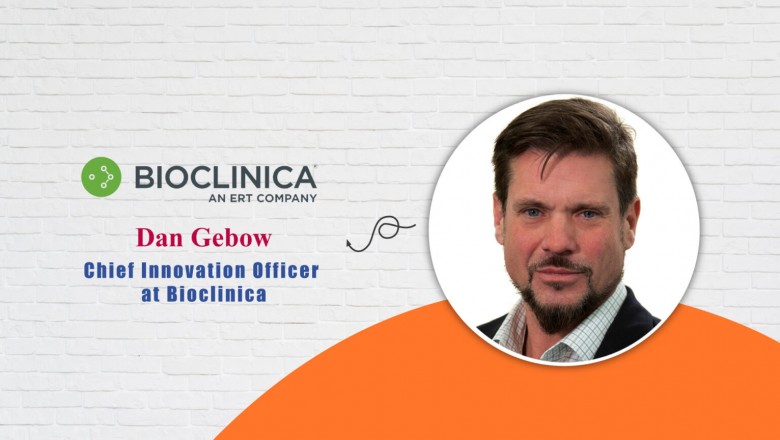okunma

Dan Gebow, PhD, Chief Innovation Officer, Bioclinica talks about the role of AI in enhancing the efficiencies of clinical trials and making a swift shift to medtech
1. Can you tell us about your role at Bioclinica?
I am the Chief Innovation Officer at Bioclinica. I oversee the company’s imaging R&D teams as well as our Innovation Program. Bioclinica’s imaging core lab processes and reads over 40,000 medical images each month and we do it using our proprietary imaging systems. The innovation department is about 40 people strong and focused on inventing new technologies that increase the speed of clinical trials through novel technology, including artificial intelligence (AI).
2. Can you tell us about your journey into this market?
I am a scientist by training with a PhD in molecular oncology. I was the Principal Investigator (PI) of a large imaging registry about 12 years ago when I became frustrated with the outdated technology I was using in my studies. Like many aspects of the healthcare industry, clinical trial data collection, processing, and review are notoriously years behind Silicon Valley standards. Research sites were still shipping CDs and hard drives with patients’ medical images in my clinical trials. These images often had patients’ names on them or were corrupted or mislabeled with the wrong patient or body part. Fed up, I decided to invent a web-based solution that could move those images through the cloud from anywhere in the world, automatically check them for issues, and de-identify protected health information (PHI). Some large medical device companies caught wind of this and asked me to offer it as a service. That resulted in the flagship product for the company I was CEO of, which Bioclinica acquired in 2017.
Since then, I’ve brought nearly a dozen novel offerings to market, ranging from clinical adjudication systems to AI-based tools. My journey was unplanned, but I’m extremely grateful. It is incredibly exciting to be inventing the future, and no two days are alike when you are ushering an invention through the creation and incubation stages. My childhood hero was Benjamin Franklin, and I’m living my dream by following in his innovative footsteps.
3. How has the emergence of AI technology in life sciences impacted clinical trials?
The availability of powerful tools to build AI models is just starting to revolutionize biomedical research. Putting aside the use of AI for corporate or financial data for a second, I’d like to focus on clinical trial data derived from studying the patient or possibly as Key Performance Indicators (KPIs) when performing a study.
I think biomedical research data is a perfect use of AI. The adage of “junk in, junk out” is even more relevant to AI than other data systems. If you are inputting messy data, then your resulting AI models will be less accurate or predictive. But in clinical trials, the goal is to control as many variables as possible and get highly accurate and validated datasets consistently, which sets a great baseline to build AI models.
4. What edge do AI capabilities provide to clinical trial sponsors today? What’s the potential in the future?
AI IS USED IN BIOMEDICAL RESEARCH TO BUILD PRAGMATIC TOOLS THAT WORK TO MAKE DATA MORE ACCURATE, ENSURE COMPLIANCE WITH PRIVACY REGULATIONS, HELP SCREEN PATIENTS FOR A TRIAL, OR ACT AS A SECOND SET OF EYES DURING DATA REVIEW.
A good example of this type of AI is Bioclinica’s invention of technology capable of redacting patients’ faces on videos used in neuromuscular or ophthalmology trials. My team spearheaded this area with a trial that recorded toddlers performing a series of movements on video. A patient’s face is considered PHI, as are the faces of nurses and parents who might appear in the video. Redacting just the eyes and nose is a very small moving target. Manual redaction took more than 30 hours per video. Semi-automated off-the-shelf tools took 30 minutes of touch-ups after processing. However, using AI, we can now redact a video in a few minutes with greater than 99.9% accuracy. Further, the great thing about AI is that when we find something it missed, the technology learns from its mistakes and doesn’t repeat them — which is a big advantage over humans.
Another way AI is used in biomedical research is detecting hidden patterns in data that are invisible to the human eye. I’ve seen more and more of this, especially in early-phase clinical trials. However, if you asked me what I thought of that use a week ago, I would have said it was futuristic and reminiscent of seeking a needle in a haystack. However, a recent publication by Bioclinica’s Director of AI, Lukasz Kidzinski, PhD, changed my perspective. He and his collaborators published a study in the prestigious Nature Medicine journal that showed smartwatch data such as heart rate was more accurate than heart rate data taken in the clinic. That’s not surprising because the smartwatch takes a lot more measurements over time. However, what was highly provocative was that when machine learning was applied to the smartwatch data, the watch data could predict the patient’s standard blood lab values such as glucose levels, hemoglobin, etc. This opens new avenues of science for companies such as ERT, which excels at the use of wearables in clinical trials and recently merged with Bioclinica.
5. Bioclinica was recently in the news for a new product that simplifies source document management in clinical trials. Can you lead us on to that?
PDFs are a primary data source in clinical trials. They can be medical records, handwritten doctor’s notes, or even images. Research sites are notorious for uploading PDFs merged into one big document, often with patient PHI littered throughout the text or written in the margins. Many times the PDFs are scanned in and might be cut off or too fuzzy to leverage.
Bioclinica’s new Source Document Manager offering addresses these common problems. The solution provides a structured data collection system, so each source document is uploaded to the correct electronic file location. Secondly, at the point of upload, the data provider can redact all PHI directly in a web browser, making it easy to comply with privacy regulations. This is important because data providers typically get it right just 2% of the time. Our technology detects the PHI and highlights it for the user so they can conduct a one-click redaction. The Source Document Manager then sends the document for translation, if needed, and then a secondary human quality control (QC) step is completed. The system knows when all required source documents are complete and can auto-route them for review directly in the system.
6. What are your views on the recent shift of medicine into the digital world?
It’s long overdue. It’s shocking to me how slow adoption has been. Let me explain by telling you a humorous personal story: I used to do many sports like mogul skiing. As a result, my knees are damaged, and I have to get X-rays or MRIs frequently. Even though I invented a cloud-based medical image data collection system that moves 40,000 images per month from over 15,000 different hospitals to be analyzed in clinical trials, I still have to go into the imaging facility, wait 30 minutes to get a copy of my images burned onto a CD, then drive it to the knee doctor’s office. Many times, they’ve had to mail the images, and they rarely arrive in time, so then the doctor’s office needs to retake the images.
The excessive cost and time waste are mind numbing, and that’s not even for a life-threatening condition. I’m very hopeful that the world of medicine my kids are raised in makes our era look as obsolete as VCRs.
7. What advice would you like to give to the upcoming AI-based startups in the same industry?
For AI startups in biomedical research and clinical trials, I can’t emphasize enough the importance of having scientific experts guiding you on which data to train and validate your models on, your targets, and the practical benefits of your AI model. In medical imaging, you can spend a lot of time building an AI model that doesn’t find what you are looking for or doesn’t have much utility for researchers.
I would also encourage anyone working with clinical data to start thinking about how their data will have a lifetime of value. This means making sure it’s clean of PHI, that the data model is standardized across all modalities and trials, and most importantly, that there are top medical or scientific experts advising you on how to categorize and annotate that data.
8. What advancements is Bioclinica planning on in the future?
Bioclinica is looking to revolutionize how medical images are screened, cleaned, and analyzed to shorten the time to analysis from days to minutes and increase the accuracy of radiologist imaging reads. I don’t foresee radiologists ever being 100% replaced by a computer as there is just too much variability in the human anatomy. However, I do foresee AI helping them work more efficiently.
Bioclinica recently merged with ERT. It’s notable because ERT offers complementary clinical trial solutions, which opens up a world of opportunity for the potential of AI. By marrying data from multiple modalities, such as eCOA (Electronic Clinical Outcome Assessment) data plus clinical adjudication or ECGs with cardiac imaging, there will be new modalities and new endpoints springing up over the next five to 10 years.
9.With the phase shift to online during this pandemic, what do you think are the transitory v/s permanent changes in clinical trials?
The pandemic proved that a significant percentage of clinical trials could be conducted remotely in decentralized studies. I was very excited that we merged with ERT when we did because they are an industry leader in remote data collection for eCOA, cardiac safety, and respiratory function analysis.
Another unexpected avenue that evolved as part of our imaging work was looking for side effects of a cancer treatment resulting in a lung condition. Unfortunately, the lung condition we are looking for can be confused with the signs of COVID on a chest CT. That inspired us to create an AI model that could detect the probability of COVID in chest CT scans. If we suspected the patient might have had undiagnosed COVID, we could automatically query the site to ask for any COVID-related records that might impact how the cancer treatment’s side effects are interpreted. This quick screen of medical images for unexpected findings using AI is now being expanded far beyond COVID detection into automated detection of all sorts of potential confounders.
For more such updates and perspectives around Digital Innovation, IoT, Data Infrastructure, AI & Cybsercurity, go to AI-Techpark.com.

Dan Gebow
Chief Innovation Officer at Bioclinica
Dan Gebow, PhD, is Chief Innovation Officer at Bioclinica. He leads digital transformation initiatives to drive technological change across the medical imaging business and accelerates the investment and productization of new tools for critical insights. He brings more than 18 years of experience in clinical research informatics and 28 years in biomedical research to this role.












